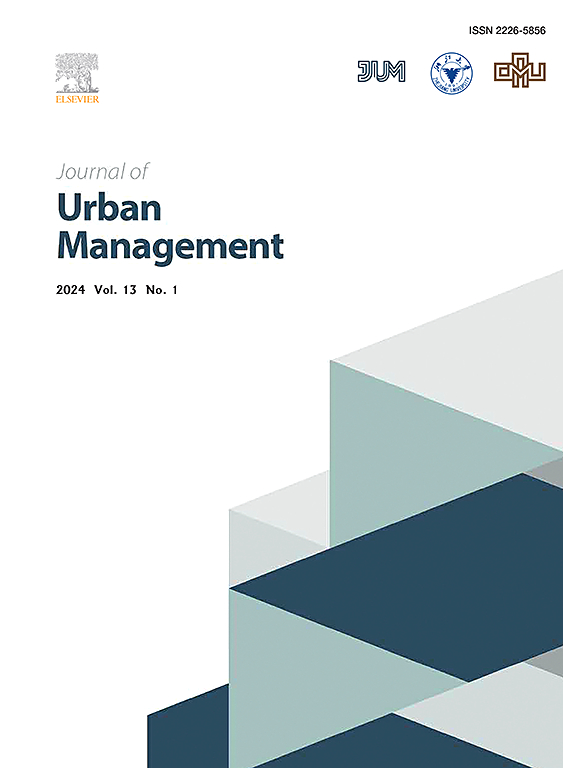Assessing the efficacy of artificial intelligence based city-scale blue green infrastructure mapping using Google Earth Engine in the Bangkok metropolitan region
IF 5
2区 社会学
Q1 URBAN STUDIES
引用次数: 0
Abstract
Urbanization disrupts natural water, energy, and nutrient cycles, but integrating green and blue infrastructures (BGI) can mitigate these effects by facilitating processes like evapotranspiration, soil water infiltration, and root nutrient absorption. In Bangkok Metropolitan Region (BMR), escalating urbanization poses challenges to these natural cycles. Mapping Land Use and Land Cover (LULC) and identifying green infrastructure locations are crucial for effective urban planning, sustainable development, and environmental conservation amidst rapid urban growth. Continuous monitoring of dynamic urban areas is time-consuming, labor-intensive, and costly. Previous research primarily focused on land use and land cover classification followed by BGI identification. An automated classification system focusing solely on BGI can greatly enhance efficiency, accuracy, and cost-effectiveness in land classification for urban planning and decision-making. However, automating this system remains a significant challenge for the remote sensing community. Therefore, the research is first to develop a cloud based artificial intelligence tools such as Smile Random Forest and Smile CART integration with Google Earth Engine (GEE) to identify BGI for BMR. For this analysis, we have used open-sources and mostly used satellite images (e.g., Landsat and Sentinel) and consider to analyze seasonal changes for waterbodies, natural vegetations and human intervened vegetations with developing cloud-based artificial intelligence (AI). Surprisingly, Landsat-9 data demonstrated superior accuracy compared to Sentinel-2, indicating that the advanced technology of Landsat 9 may be more effective for BGI classification using AI. The study revealed a most distinct transition from deep green to green infrastructures during the transition from summer to monsoon season, whereas significant changes in blue infrastructure occurred between the monsoon and winter seasons. Seasonal variations in BGI are complex and influenced by factors such as the types of BGI implemented and the nuances of local climatic conditions. These advancements could provide precise insights for urban managers and policymakers, offering valuable tools to identify and understand BGI dynamics across various urban scales.

利用谷歌Earth Engine评估基于人工智能的曼谷大都市区蓝绿色基础设施测绘效果
城市化破坏了自然的水、能量和养分循环,但整合绿色和蓝色基础设施(BGI)可以通过促进蒸散、土壤水分渗透和根系养分吸收等过程来缓解这些影响。在曼谷都市圈(BMR),不断升级的城市化对这些自然循环提出了挑战。在城市快速发展的背景下,绘制土地利用和土地覆盖(LULC)地图以及确定绿色基础设施位置对于有效的城市规划、可持续发展和环境保护至关重要。对充满活力的城市地区进行持续监测既耗时又费力,而且成本高昂。以往的研究主要集中在土地利用和土地覆盖分类,其次是华大基因识别。一个完全以华大基因为中心的自动分类系统可以大大提高城市规划和决策的土地分类的效率、准确性和成本效益。然而,该系统的自动化仍然是遥感界面临的重大挑战。因此,本研究首先开发基于云的人工智能工具,如Smile Random Forest和Smile CART与谷歌Earth Engine (GEE)的集成,以识别BMR的BGI。在这项分析中,我们使用了开源的卫星图像(例如Landsat和Sentinel),并考虑通过开发基于云的人工智能(AI)来分析水体、自然植被和人为干预植被的季节变化。令人惊讶的是,与Sentinel-2相比,Landsat-9的数据显示出更高的精度,这表明Landsat 9的先进技术可能更有效地利用人工智能进行华大基因分类。研究表明,在夏季到季风季节的过渡期间,基础设施从深绿色到绿色的转变最为明显,而在季风和冬季之间,基础设施的蓝色发生了显著变化。BGI的季节变化是复杂的,并受到诸如实施的BGI类型和当地气候条件的细微差别等因素的影响。这些进步可以为城市管理者和政策制定者提供精确的见解,为识别和理解不同城市规模的华大基因动态提供有价值的工具。
本文章由计算机程序翻译,如有差异,请以英文原文为准。
求助全文
约1分钟内获得全文
求助全文
来源期刊

Journal of Urban Management
URBAN STUDIES-
CiteScore
9.50
自引率
4.90%
发文量
45
审稿时长
65 days
期刊介绍:
Journal of Urban Management (JUM) is the Official Journal of Zhejiang University and the Chinese Association of Urban Management, an international, peer-reviewed open access journal covering planning, administering, regulating, and governing urban complexity.
JUM has its two-fold aims set to integrate the studies across fields in urban planning and management, as well as to provide a more holistic perspective on problem solving.
1) Explore innovative management skills for taming thorny problems that arise with global urbanization
2) Provide a platform to deal with urban affairs whose solutions must be looked at from an interdisciplinary perspective.
 求助内容:
求助内容: 应助结果提醒方式:
应助结果提醒方式:


